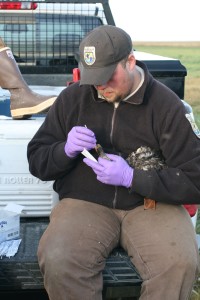When working with a post doc student from North Dakota State University, we studied the life history of the endangered Mohave Tui Chub, we conducted several mark and recapture studies to determine the population on several bodies of water. The two main ponds we focused on were, Lake Tuende and MC Spring on the grounds of the Desert Studies Center at Zzyzx, CA.

We clipped the right pectoral fin on all of the fish we caught in our minnow traps one day, and repeat the experiment the next day to see how many individuals we recaptured. To determine what the population is, you multiply the number of individuals marked the first day by the number of animals captured on the second visit divided by the number of marked animals captured the second day (See wikipedia article for math notation).












